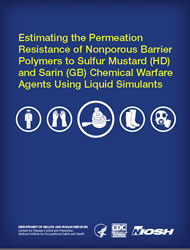| |
The purpose of this document is to report the results of the NIOSH Chemical Warfare Agent (CWA) Simulant Project that had the following goals: 1.) Identify chemicals (simulants) that simulate the permeation of Sarin (GB) and sulfur mustard (HD) through elastomeric barrier materials that are commonly used in respirators. 2.) Develop a convenient and reliable laboratory procedure (test method) that can be used by Personal Protective Equipment (PPE) manufacturers for estimating GB and HD permeation rates through barrier materials using the simulants. PPE manufacturers can use this method to screen and deselect candidate barrier materials during product development testing. Advancements in this research can benefit the first responder community by providing PPE manufacturers with information and testing techniques that will reduce the time and resources needed to engineer products that weigh less, have better permeation resistance, are less cumbersome, and could potentially be less expensive.
This document was prepared by the NIOSH, National Personal Protective Technology Laboratory (NPPTL) in collaboration with the U.S. Army Research, Development and Engineering Command (RDECOM) including staff from the Edgewood Chemical Biological Center (ECBC) and the Natick Soldier Center (NSC).
| Entire Document |
2008-141.pdf
(2,091KB; 97pgs) |
| The
free Adobe Acrobat Reader is needed to view these files. |
 |
|
 |
 |














